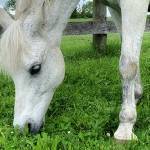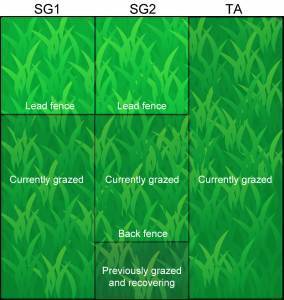Strip-Grazing: Management Tool to Fight Obesity

Researchers and veterinarians rail against keeping horses and ponies overweight, citing both short- and long-term health complications, including insulin dysregulation and laminitis. When kept on good-quality pasture, weight management can become problematic as forage intake soars, potentially leading to obesity. Limiting grazing time and using muzzles can help, but horses are adept at consuming large quantities of forage in a short time, and muzzles require daily observation for signs of discomfort and rubs at pressure points.
Frustrated with these strategies, some owners implement a management technique called strip-grazing, which involves using a movable fence to provide sufficient forage for a short time and then moving the fence to allow access to fresh forage. Researchers in the United Kingdom investigated the efficacy of three strip-grazing practices on the body weight of ponies over a 28-day period.* Twelve ponies with an average body score of nearly 5.5 were divided into three groups of four, matched for body weight, height, and body condition score. None of the ponies had ever been diagnosed with laminitis.

This diagram shows the configuration of each type of paddock in the study. The two strip-grazed paddocks are labeled SG1 and SG2, and the total-access paddock is labeled TA. The paddock layout was adapted from Longland et al. (2021). Click here to view full-size image.
Researchers divided a level, biodiverse pasture into 12 side-by-side paddocks using electric tape, all 10 m wide and initially 75 m long. Four paddocks had no additional partitioning. Another four paddocks had a moveable fence within its borders to create a “lead” fence, and four paddocks had two moveable fences within, the lead fence and the “back” fence, which cordoned off a previously grazed area. The lead fence was moved a set distance daily to provide ponies with approximately 1.5% of body weight in herbage dry matter. In the paddocks with both lead and back fences, both were advanced equal distances daily. See a diagram of the paddock configuration.
The three treatments coincided with the different paddocks: (1) total access with no strip-grazing; (2) strip-grazing with only a lead fence; and (3) strip-grazing with a lead and back fence.
Researchers calculated dry matter intake and documented changes in body weight, cresty neck score, and changes in body weight, heart-girth circumference, belly-girth circumference, and rump width.
What did researchers find?
- Intake. Ponies in the total-access group consumed significantly more herbage than ponies in the strip-grazing configurations, an average of 2.3% of body weight. The ponies that were strip-grazed consumed between 1.6% and 1.8% of body weight.
- Body weight. Given the greater consumption, it comes as no surprise that body weight changes were most pronounced in the total-access group, as those ponies gained significantly more weight than their strip-grazed peers, whose weight changes were not significant.
- Morphometric changes. Ponies in the total-access group had significantly higher body condition score, cresty neck score, belly-girth circumference, and rump width.
“With this group of ponies, researchers found that strip-grazing proved a valuable tool in managing body weight,” summarized Catherine Whitehouse, M.S., a nutrition advisor with Kentucky Equine Research. “While this style of grazing management is used more frequently in certain parts of the world, like the United Kingdom and Australia, horse owners elsewhere may find value in it, especially if real-world results mirror those found in this study.”
*Longland, A.C., C. Barfoot, and P.A. Harris. 2021. Strip-grazing: Reduces pony dry matter intakes and changes in bodyweight and morphometrics. Equine Veterinary Journal. doi:10.111/evj.13416








